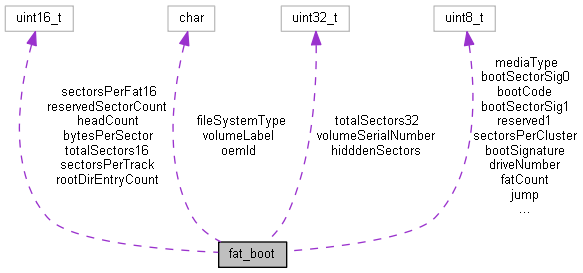|
Prusa MINI Firmware overview
|
|
Prusa MINI Firmware overview
|
Boot sector for a FAT12/FAT16 volume. More...
#include <SdFatStructs.h>

Public Attributes | |
| uint8_t | jump [3] |
| char | oemId [8] |
| uint16_t | bytesPerSector |
| uint8_t | sectorsPerCluster |
| uint16_t | reservedSectorCount |
| uint8_t | fatCount |
| uint16_t | rootDirEntryCount |
| uint16_t | totalSectors16 |
| uint8_t | mediaType |
| uint16_t | sectorsPerFat16 |
| uint16_t | sectorsPerTrack |
| uint16_t | headCount |
| uint32_t | hidddenSectors |
| uint32_t | totalSectors32 |
| uint8_t | driveNumber |
| uint8_t | reserved1 |
| uint8_t | bootSignature |
| uint32_t | volumeSerialNumber |
| char | volumeLabel [11] |
| char | fileSystemType [8] |
| uint8_t | bootCode [448] |
| uint8_t | bootSectorSig0 |
| uint8_t | bootSectorSig1 |
Boot sector for a FAT12/FAT16 volume.
| uint8_t fat_boot::jump[3] |
The first three bytes of the boot sector must be valid, executable x 86-based CPU instructions. This includes a jump instruction that skips the next nonexecutable bytes.
| char fat_boot::oemId[8] |
This is typically a string of characters that identifies the operating system that formatted the volume.
| uint16_t fat_boot::bytesPerSector |
The size of a hardware sector. Valid decimal values for this field are 512, 1024, 2048, and 4096. For most disks used in the United States, the value of this field is 512.
| uint8_t fat_boot::sectorsPerCluster |
Number of sectors per allocation unit. This value must be a power of 2 that is greater than 0. The legal values are 1, 2, 4, 8, 16, 32, 64, and 128. 128 should be avoided.
| uint16_t fat_boot::reservedSectorCount |
The number of sectors preceding the start of the first FAT, including the boot sector. The value of this field is always 1.
| uint8_t fat_boot::fatCount |
The number of copies of the FAT on the volume. The value of this field is always 2.
| uint16_t fat_boot::rootDirEntryCount |
For FAT12 and FAT16 volumes, this field contains the count of 32-byte directory entries in the root directory. For FAT32 volumes, this field must be set to 0. For FAT12 and FAT16 volumes, this value should always specify a count that when multiplied by 32 results in a multiple of bytesPerSector. FAT16 volumes should use the value 512.
| uint16_t fat_boot::totalSectors16 |
This field is the old 16-bit total count of sectors on the volume. This count includes the count of all sectors in all four regions of the volume. This field can be 0; if it is 0, then totalSectors32 must be nonzero. For FAT32 volumes, this field must be 0. For FAT12 and FAT16 volumes, this field contains the sector count, and totalSectors32 is 0 if the total sector count fits (is less than 0x10000).
| uint8_t fat_boot::mediaType |
This dates back to the old MS-DOS 1.x media determination and is no longer usually used for anything. 0xF8 is the standard value for fixed (nonremovable) media. For removable media, 0xF0 is frequently used. Legal values are 0xF0 or 0xF8-0xFF.
| uint16_t fat_boot::sectorsPerFat16 |
Count of sectors occupied by one FAT on FAT12/FAT16 volumes. On FAT32 volumes this field must be 0, and sectorsPerFat32 contains the FAT size count.
| uint16_t fat_boot::sectorsPerTrack |
| uint16_t fat_boot::headCount |
| uint32_t fat_boot::hidddenSectors |
Count of hidden sectors preceding the partition that contains this FAT volume. This field is generally only relevant for media visible on interrupt 0x13.
| uint32_t fat_boot::totalSectors32 |
This field is the new 32-bit total count of sectors on the volume. This count includes the count of all sectors in all four regions of the volume. This field can be 0; if it is 0, then totalSectors16 must be nonzero.
| uint8_t fat_boot::driveNumber |
Related to the BIOS physical drive number. Floppy drives are identified as 0x00 and physical hard disks are identified as 0x80, regardless of the number of physical disk drives. Typically, this value is set prior to issuing an INT 13h BIOS call to specify the device to access. The value is only relevant if the device is a boot device.
| uint8_t fat_boot::reserved1 |
| uint8_t fat_boot::bootSignature |
| uint32_t fat_boot::volumeSerialNumber |
A random serial number created when formatting a disk, which helps to distinguish between disks. Usually generated by combining date and time.
| char fat_boot::volumeLabel[11] |
A field once used to store the volume label. The volume label is now stored as a special file in the root directory.
| char fat_boot::fileSystemType[8] |
A field with a value of either FAT, FAT12 or FAT16, depending on the disk format.
| uint8_t fat_boot::bootCode[448] |
| uint8_t fat_boot::bootSectorSig0 |
| uint8_t fat_boot::bootSectorSig1 |